The making of Fallout Tactics: 'I sound like I'm down on it now, but I still love what we made'
A green team with huge ambitions—what could possibly go wrong?
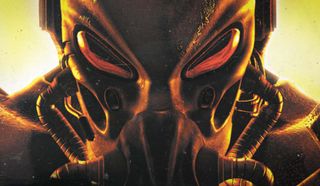
We didn't call them memes in 2001. But insofar as viral internet jokes existed, hairy deathclaws became a meme. More specifically, they became a stick to beat Fallout Tactics developer Micro Forté with. The studio had invented a take on the iconic monster that was covered in thick fur—a natural coat which provided top-notch protection from the weather. "Because it looks like it's there in the sprite," lead designer Ed Orman says. "Now I actually think there's plenty of justification for doing variations on deathclaws. But at the time, it was sacrilege."
The hairy deathclaw is, in many ways, emblematic of Fallout Tactics—a bold and slightly strange genetic offshoot of the beloved RPG series, reverse-engineered by an enthusiastic team. It's a wistful reminder of a time before the Bethesda reboot in which the future of Fallout had yet to be written—and for all we knew, might feature a Brotherhood of Steel who sped around the ruined city of Chicago in Humvees, desperate for new recruits.
Rewind to May 1999, when Micro Forté put out a forgotten squad tactics game named Enemy Infestation. A real-time take on XCOM, it was praised by PC Gamer for its "good storyline", lampooned for its "hambone voice acting", and judged as "worth playing if someone gave it to you as a gift—maybe."
Against the odds, it put the inexperienced developer in prime position to contribute to one of the most beloved series in gaming. "We finished that game, and then we moved onto another one, which was called Chimera Project I think," Orman says. "It had a bunch of different names. We made a full playable demo to pitch."
At some stage, that demo reached Interplay, who came back with a counter-pitch: how about you make a Fallout game? It's not quite the wild punt it seems when you consider what the publisher was looking at. Micro Forté had built an isometric, tile-based engine which, if you squinted a little, already resembled a shiny version of the quintessential post-apocalyptic RPG.
"It had some bells and whistles that the Fallout engines didn't have," Orman says. "Graphically, it was just more advanced. Even the color palettes that we had available were better than what was in the original Fallout games, and we were rendering sprites at higher res."
Future shock
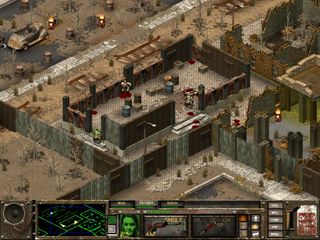
Even so, this serendipitous deal came as a fantastic shock—particularly to Orman, who had grown up with the '50s music and Americana that distinguished Fallout, and regularly played in the radiation-soaked tabletop setting of Gamma World. "I thought Fallout was this amazing melding of these things," he says. "I was blown away by the idea that they would put us in charge of anything with any pre-existing value, because we were a totally new team."
The biggest gaming news, reviews and hardware deals
Keep up to date with the most important stories and the best deals, as picked by the PC Gamer team.
That thought would come back to haunt him. But Interplay did take steps to try and limit the responsibility it was loading on Micro Forté. Namely, it decided that the game would be Fallout Tactics—a spinoff rather than a numbered entry in the series.
"Making a full-fledged RPG with a brand new team, with the complexity Fallout has, it's a big ask," Orman says. "We still made something ludicrously complex anyway. But I think the idea was to do this offshoot, and not have to adhere to all of the conventions of the mechanics that are usually in a Fallout game."
Fallout Tactics would focus on the turn-based combat system that had powered the two previous games in the series. But Micro Forté simultaneously developed a real-time version that would give players the option of steering their squad and setting up ambushes without pausing the action—the brainchild of lead programmer Karl Burdack.
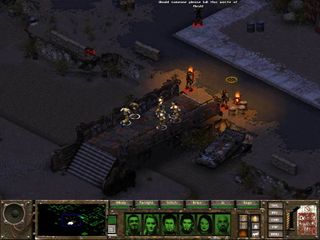
"Probably the turn-based stuff had been identified as not having as large an appeal. You can reach more people if you're real-time," Orman says. "But I also think, when we first got an implementation of it, we all enjoyed it greatly, too. It was still using all the same artwork and all the same game systems and everything, but having it run in real-time was just so much faster, and it was cool to see everything kicking off."
Given the size of the levels in Fallout Tactics and the length of its protracted engagements with raiders, the real-time option became less a novelty and more a necessity. "That was something that came out of playing the original Fallouts," Orman says. "The horrible situation where you ended up with one enemy and couldn't figure out where they were on the map, and you were just turn-based walking around - that was always a painful end game. So at least we solved that."
Having it run in real-time was just so much faster, and it was cool to see everything kicking off.
Ed Orman, lead designer
The militarised premise of Fallout Tactics pushed the team towards the Brotherhood of Steel—the Fallout faction with a predisposition towards tactical training and squad-based operations. In a curious pre-echo of Bethesda's Fallout 3, Micro Forté severed the cord that connected its Brotherhood soldiers to the faction's founders in California. The studio imagined an ideological schism that left a bunch of power-armored, power-hungry survivors stranded out east in Chicago.
"Separating them from the main Brotherhood was really important so that we could do something different with this group," Orman says. "They're survivalists at this point, they're not the holy Brotherhood." Like the later Brotherhood of New Vegas, the faction of Fallout Tactics is grappling with the problem of recruitment—whether to compromise its insular way of life by taking on newcomers from the wastes, or risk dying off in its bunkers.
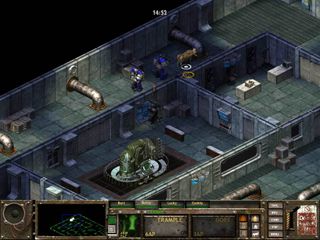
"I really enjoyed killing off the nobility of them," Orman says. "Anybody who gets that level of power through all of their technology, post-apocalyptically, I don't believe they're going to remain a noble enterprise. I don't think the Brotherhood was really, deep down, all that noble anyway."
If you don't throw narrative curveballs the Brotherhood's way, Orman says, they're basically a steamroller. "They are the perfect superpower that exists post-apocalyptically, and they're just going to spread. I think there is a legit game where the Brotherhood are the main bad guys, 100 years in the future. Because they're just unstoppable."
The bigotry of the Brotherhood became a core theme of Fallout Tactics' story. "It's built into their ethos," Orman says. "In Gamma World there's this concept of pure strain humans, and I know that concept is in Fallout as well from the Brotherhood's perspective. So I really liked playing with that."
One of the endings Micro Forté designed for Fallout Tactics saw the player's gaggle of veterans become almost unrecognisable as the Brotherhood of Steel. "They are open to everybody at that point," Orman says. "It's not just the technology, it's the people. They basically get over all of their prejudices and accept that survival requires everybody's help. I always liked that note."
Hard road
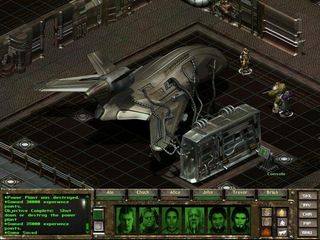
As you might have gathered by this point, Micro Forté didn't take the easy route when it came to scoping its spinoff. It volunteered to make a sprawling story campaign, as well as a multiplayer component. Like Icewind Dale in the wake of Baldur's Gate, this was an action-focused RPG spinoff that sacrificed nothing in terms of worldbuilding, crunchy stat management and looted equipment.
"Standalone missions would have been so much better, instead of the contiguous world that we were trying to create," Orman says. "Because you can just pace out the equipment that the player has and the enemies that you're encountering, and take the player through the variation that's in the game. Instead, we were the opposite. We were incentivizing you to keep your squad alive."
By the midgame, players were in command of powerful squaddies bristling with every gun they'd picked off a corpse during previous missions. Balancing the difficulty quickly became Orman's biggest problem, and dogged him throughout development. "It was possible to overwhelm all of the mechanics by equipping the right amount of weaponry with an almost unlimited ammo source, because we didn't balance the economy correctly," he says. "So there were parts where you could just select everybody and rush through."
It's no wonder that Micro Forté made mistakes, given that it was greener than the mutants. The most experienced team member by far was Tony Oakden, a producer who had worked on Driver in the UK. "I was always naively pushing back against him, saying, 'No, we can't cut this thing, this has to be in here,'' Orman says. "He almost certainly could see the writing on the wall."
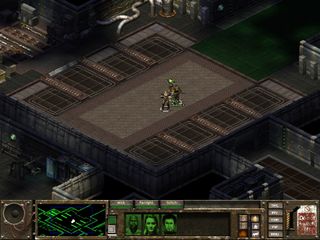
Orman himself was made lead designer and associate producer based on very little game design experience. "I was not qualified, other than I'd played a lot of role-playing games in my life, so I understood rules, and had played a lot of Fallout, so I understood Fallout," he says. "I pretty much stumbled straight into it."
There's a sense, too, that Interplay had set Micro Forté an impossible problem. There was no obvious way to split the difference between the sprawl of Fallout—a universe that always said yes to the player and gave them choices wherever possible—and a tight, combat-first tactics game.
"It sits uncomfortably in the middle, and that was always the problem, and one of the joys of it," Orman says. "If we'd had another year from the start, we'd have had the time to plan and balance these things out properly. I think it would have been a much better Fallout game. But it needed more time or less features. It needed to choose one direction or the other."
That said, it's the big, inadvisable swings of Fallout Tactics that stick fondly in the memory—like the bunker hub where characters from previous missions gradually show up for chats. "I love that you go back to the base, and you have the quartermaster that you can talk to and sell your crap to," Orman says. "It just makes everything feel so much more cohesive."
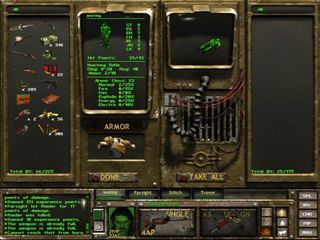
Let's not forget, too, that Fallout Tactics remains the only game in the series to officially support driveable vehicles. "That was an insane thing to try and take on, but we did," Orman says. "Because it was a squad-based game, you want a way to move all your guys together—stick them in a vehicle and off you go. They took up huge amounts of memory and had navigation problems, because the world was built for humanoid, upright characters. But they were a lot of fun to put in."
All this ambition made Fallout Tactics a tricky game to pull together. Micro Forté wasn't helped by the fact that art assets they'd been promised by Interplay from the first two Fallout games never materialised. "We lost months," Orman says. "That was a huge leg sweep. Every single thing that came over from a Fallout game, we had to recreate from scratch. That was just a huge slog."
Every single thing that came over from a Fallout game, we had to recreate from scratch. That was just a huge slog.
Ed Orman, lead designer
It's a feat akin to recreating the sound of the Beatles' albums without access to Abbey Road. And it's testament to the team's skill in reverse-engineering that, for the most part, Fallout Tactics is steeped in the same crackling atmosphere and post-societal murk as the original games. Not that their efforts were appreciated by a punishing fanbase at launch. Despite the input of original Fallout co-creator Chris Taylor, who acted as a living lore bible, the team "got some things wrong".
"The art team in particular were super gutted, because a lot of the visuals of the robots which they had slaved away on, those were the things that were getting dinged for not fitting the aesthetic," Orman says. "Visually, it was really easy to point at things and go, 'This doesn't fit the universe.' So they copped it hard. You want to make the fan base happy. You want to make another one too. So it was a gut punch.

Micro Forté had plans for a sequel. Fallout Tactics 2 was intended to address the issues of its predecessor, with a smaller campaign, simplified economy, and new setting in the form of the deep South. "Which gave us lots of opportunities for new mutations and creatures that you hadn't seen before in Fallout," Orman says. "The idea was that there was an Eden Kit that was creating intelligent plant hybrids. Now you can't tell the environment from the enemies, and there's more of a guerrilla warfare sort of feeling to the missions."
Instead, once Fallout Tactics was finished, the team was subjected to "awful" layoffs. "Emotionally, it sucks," Orman says. "From a business sense, it's really bad business. If there is any way you can maintain those teams, they will generate more for you, because they have this bond already and this experience together."
Nonetheless, members of the Fallout Tactics team went on to great things—working at Irrational Australia on the likes of BioShock, and contributing to the country's vibrant indie scene. And over time, despite being declared non-canon by Todd Howard, elements of Fallout Tactics have crept into sequels and into the hearts of series fans. Like the Brotherhood, the Fallout hardcore has slowly seen the value in embracing the mutants on the periphery of the world they so jealously guard.
"The team was a great bunch of people who pulled off a ridiculous feat in creating a game with nowhere near as much money as it needed to have, with not enough time, all of these things against it. And the fact that we all made that game is still really, really awesome to me," Orman says. "I sound like I'm down on it now. With years of hindsight you can see your own mistakes much more clearly. But I still love what we made."
Most Popular


